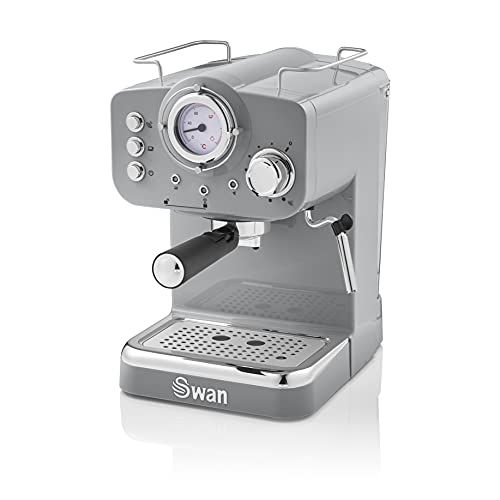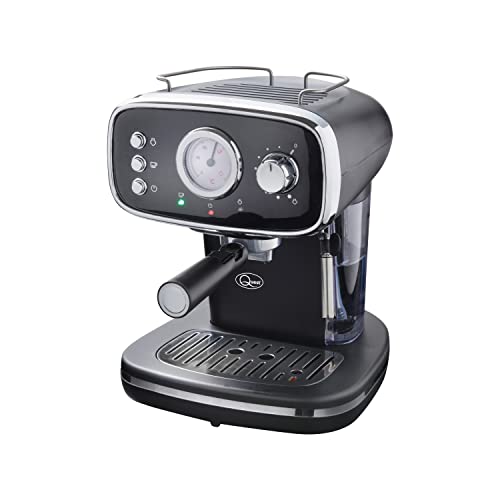11 Strategies To Completely Defy Your Machine Espresso

2025-02-12 11:19
64
0
본문
 How Does Machine Espresso Work?
How Does Machine Espresso Work? The machine espresso utilizes precision pressure, and a filtering technology that is amazing to create the coffee you enjoy. What exactly is it?
The machine espresso utilizes precision pressure, and a filtering technology that is amazing to create the coffee you enjoy. What exactly is it?To make an espresso, hot water is pushed under pressure through finely ground coffee. The process is similar to making drip coffee but the key difference is in the pressure.
The Head of the Group
The group head is the portafilter that you insert when brewing espresso. It disperses the water into the portafilter, and then regulates the pressure of the extraction. There are a variety of group heads each with its own advantages and disadvantages. Some are focused on temperature stability, while others on pre-infusion capabilities, while others are designed to control the lever. There are also some that come with a range of features, like the E61 one, which is the classic choice among many baristas for its ability to provide multiple benefits in a single package.
As you can see in the photo above the group head is equipped with several notches. The portafilter is placed inside these notches, and then twist the head to lock it. There is also a gasket of rubber which is located inside the notches and helps to create an airtight seal when you insert your portafilter into the machine. The notches on the head allow for an exact positioning of the portafilter which is vital for an efficient extraction.
The group head not only lets you to put in your portafilter easily, but it also maintains the temperature at a constant level. This is done by cycling hot water around the portafilter and through the brew basin, ensuring that the temperature is always at the right level for extraction. It is crucial to keep in mind that even a best small espresso machine difference can make the difference between a good and excellent espresso.
The Pump
In contrast to piston machines that are manually operated, that use a lever to pressurize water, Rotary espresso machines rely on motorized pumps to deliver the nine atmospheric bars of pressure needed to extract espresso. This pressure is generated by pumping water through a heat exchanger and then through the ground coffee.
Pumps are typically less expensive and last longer than piston-driven machines. However, both types of machines can degrade because of excessive use and poor cleaning. Pumps are also more complex mechanically, and can add to prices of even simpler models.
Some espresso machines employ steam pressure instead of a pump for brewing professional espresso maker. This could lead to over-extraction since the boiler that produces steam also heats the water to boil. The machines also need to constantly rebuild their pressure in between cups. This takes energy and time.
A large majority of espresso machines employ the rotary or vibration pump. A vibration model utilizes a rotating disk to generate pressure, while a Rotary model pushes hot coffee through the ground at high speed. Both types of machine can produce an excellent espresso, however the rotary pumps are quieter, and more durable than vibration pumps.
The Boiler
The boiler is the component that heats water to the optimal temperature to extract. The steam produced will eventually reach the portafilter, which is a container for espresso grounds. The steam is then channeled into the cup. During this process the steam is able to create enough pressure to push the grounds of the coffee through. This creates a foam on the top of the espresso. This is one of the hallmarks of a great espresso.
There are three kinds of espresso makers, commercial espresso machine which differ in the kind of pump they use and [Redirect-Java] the degree of heat that the espresso is. There are different ways in which the brew could be controlled, as well as the size of the cup the machine is capable of making.
The first espresso machines were steam-types. They employed only one boiler to make both steam and brew however the pressure they were able to generate was low - only two bars of atmospheric pressure maximum. The coffee tasted bitter and burnt. The modern espresso machine was invented by the Milanese manufacturers Luigi Bezzerra & Desiderio Pavoni.
The most common retro espresso maker machine is a semiautomatic with an electric pump. This is what people envision when they think of an espresso maker. With a semi-automatic espresso coffee machines machine, you must grind the beans and then tamp them by hand. The pump provides regulated water flow and pressure. This is a fantastic solution that combines human control with mechanized accuracy.
The Filter
Typically, espresso machines utilize filters that separate the grounds of coffee as they move through the hot water. The filter is also an important element of the temperature control system, since it helps prevent the machine from overheating.
A filter also helps with flavor as it allows for an extended flowering time. This allows the beans to release their flavor and improves extraction.
However it is crucial to remember that even a top filter could result in a bad cup of coffee, since the quality of the beans and extraction are important.
This is where the magic happens, it's what makes espresso taste great. The grouphead, often called the brew head, is the place where the portafilter (the container you place the ground coffee in) is located when you're making espresso.
In an buy espresso machines machine that is driven by steam, hot water is heated in an airtight container to create steam. This then pushes the hot water through the grounds under high pressure. These types of machines are usually less expensive and easier to maintain than pump-driven models. They are however limited to create the perfect conditions for brewing, as they operate with 1-1.5 bar of pressure. The ideal shot requires 9-10 bars.
In recent years, compressed air-driven espresso machines have been gaining popularity. They utilize an air compressor to force hot water into the ground and are much more mobile than steam-driven electric mini Espresso maker machines.

댓글목록0